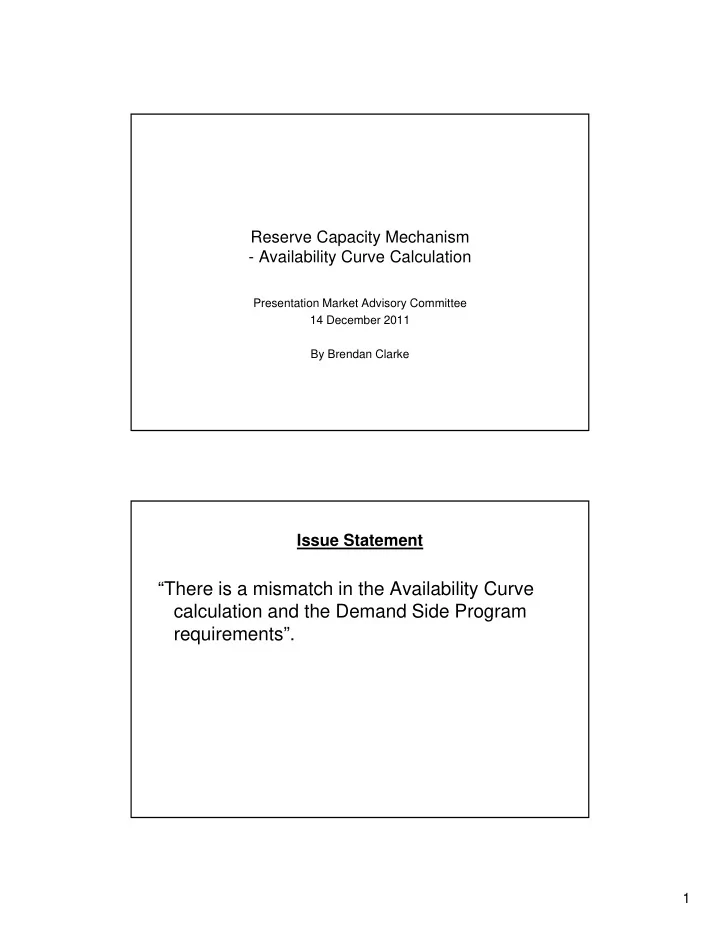

Reserve Capacity Mechanism - Availability Curve Calculation Presentation Market Advisory Committee 14 December 2011 By Brendan Clarke Issue Statement “There is a mismatch in the Availability Curve calculation and the Demand Side Program l l ti d th D d Sid P requirements”. 1
Issue Market rule 4.5.12(c) defines the Availability Curve calculation that assigns the amount of load that can be served by Demand Side Program classes based on 48, 72, 96 hour/year needs “the capacity associated with each Availability Class where: i. the capacity quantity associated with Availability Class 4 is the Reserve Capacity Target for the Capacity Year less the greater of the quantity specified under paragraph (b) and the quantity specified under paragraph (a) as being required for more than 48 hours per year;” Appendix 3 defines the class availability requirements for each DSP class, based on 24- 48, 48-72, 72-96, >96 hour segments. Issue Appendix 3 links the two together to determines how the reserve capacity procurement offers are accepted and “is used to prevent the IMO accepting bilateral trades that have insufficient availability to usefully address the Reserve Capacity Requirement” This is an 11 step process. The key step is step 3 Step 3: Accept offers from the set of active offers in order of � In the case of testing bilateral schedules, decreasing availability. � In the case of the reserve capacity auction, increasing price until the capacity requirements of Availability Class “a” are fully covered or until there are no offers left unaccepted in the set of active offers. This leads to a mismatch in the DSP requirement and the load need This is illustrated in the load duration curve characteristics shown in the following slide 2
Class 4 Class 4 MR 4.5.12 Calculation – 2013/14 data Min Optional Req Req Load (MW) 5219MW Load that is adequately served by class 4 DSP Class 4 or 3,2,1 or 3 2 1 Load that may not be served by class 4 DSP if all 4806MW offers are at 24 hours 4694MW Class 3 or 2,1 4631MW Class 2 or 1 4590MW Class 1 24 48 72 96 Hours/year Proposed Resolution The Availability curve assigns the amount of load that can be served based on 24, 48, 72 hour/year needs (market rule 4.5.12(c)). y ( ( )) The availability requirements for each DSP class is based on 24-48, 48-72, 72-96, >96 hour segments is unchanged (appendix 3). This removes the mismatch in the DSP requirement and the load duration needed This is illustrated in the load duration curve characteristics shown in the following slide 3
Class 4 Min Req Load (MW) 5219MW Load that is serve by class 4 DSP Class 4 Reduced by 112MW or 3,2,1 Load that is serve by class 3 DSP Load that is serve by class 3 DSP 4806MW Class 3 Increased by 49MW or 2,1 4694MW Load that is serve by class 2 DSP Class 2 Increased by 22MW or 1 4631MW Load that is serve by class 1 DSP Increased by 41MW Class 1 24 48 72 96 Hours/year Comment This does not alter the availability class requirements, class 4 is still 24 to 48 hours and DSP can nominate 24 hours 48 hours and DSP can nominate 24 hours This does not limit the amount of DSP that can be offered 4
Way Forward A Pre Rule Discussion Paper is discussed & noted by MAC System Management submits a Rule Change Proposal with a request for S t M t b it R l Ch P l ith t f change prior to the next SOO 5
Recommend
More recommend